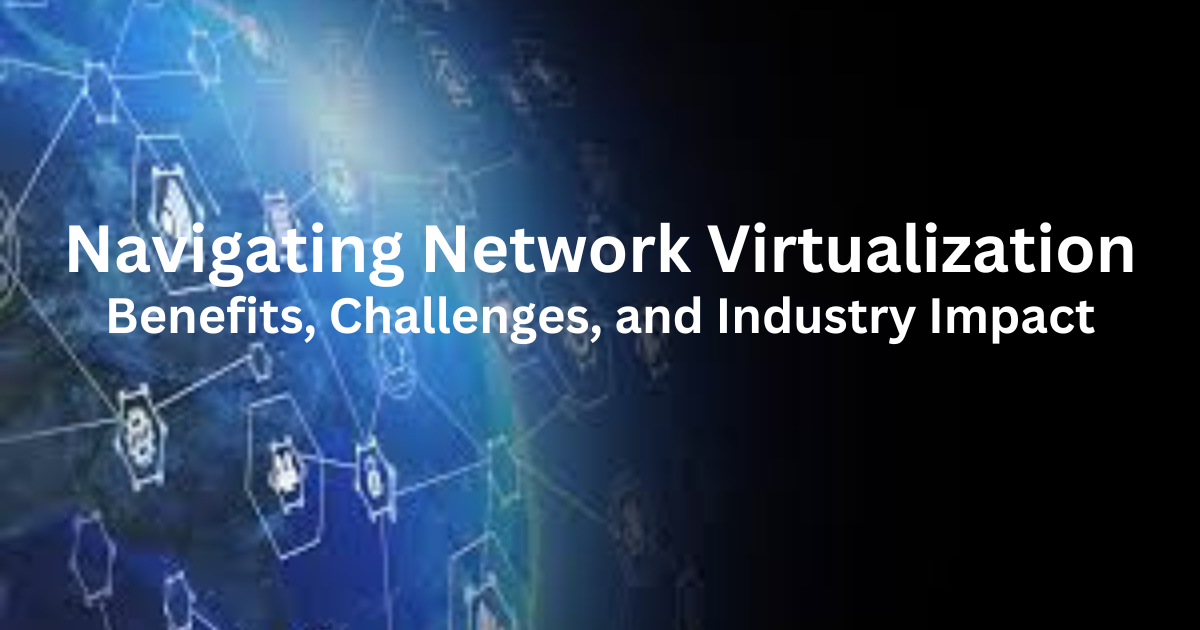Introduction to Network Virtualization
In the landscape of modern IT infrastructure, the concept of network virtualization has emerged as a cornerstone for businesses seeking robust and flexible networking solutions. Network Virtualization fundamentally involves the abstraction of network resources from hardware, allowing for the creation of software-based representations. Its importance lies in enhancing network efficiency, security, and scalability, transforming traditional networking methods.
Understanding the Basics of Network Virtualization
At its core, network virtualization comprises various components. These include the creation of multiple virtual networks, the allocation of independent channels, and the abstraction of resources. Types of network virtualization, such as internal, external, and tunneling, offer varied approaches to achieving virtualization. The functioning involves separating available bandwidth into distinct channels, enabling the assignment of specific servers or devices to these channels.
Advantages of Network Virtualization
Network virtualization offers a wide array of benefits to organizations across various industries, transforming the way they manage and utilize their network infrastructure. Some of the key advantages include:
Enhanced Security:
One of the primary advantages of network virtualization is the bolstering of security measures. By creating multiple virtual networks, it becomes easier to isolate and secure data traffic, reducing the risk of unauthorized access or breaches. Segmentation allows for stricter control over data, enhancing overall network security.
Flexibility and Scalability:
Virtualization offers a high degree of flexibility, enabling the creation of multiple virtual networks independent of the physical infrastructure. This allows for dynamic allocation of resources, quick adjustments, and scalability as per the changing needs of an organization. It ensures that network configurations can easily adapt to evolving demands without requiring extensive hardware modifications.
Cost-effectiveness:
By abstracting network resources from the underlying hardware, organizations can reduce the reliance on physical components. This minimizes the need for expensive hardware upgrades or replacements, leading to cost savings. Additionally, the optimized utilization of resources and the ability to provision new services swiftly result in operational cost reductions.
Resource Optimization:
Network virtualization optimizes resource usage by efficiently allocating available bandwidth and computing resources. The ability to allocate these resources dynamically as per the current demands minimizes waste and maximizes utilization. This helps in achieving better performance levels without overprovisioning.
Streamlined Management:
Virtual networks can be managed centrally through software applications, allowing for simplified network management and automation. It eases the configuration, monitoring, and maintenance of the network, reducing the complexity associated with traditional networking systems.
Disaster Recovery and Redundancy:
Virtualization facilitates easier Disaster Recovery solutions. Creating virtualized backups and replicas of networks and resources ensures business continuity and minimal downtime in case of system failures or disasters.
Support for Innovation and Experimentation:
Virtualized environments offer a safe space for testing and experimentation without impacting the primary network infrastructure. This fosters innovation and the development of new services and applications without risking the stability of the existing network.
Improved Performance:
Network virtualization can enhance overall network performance by segmenting traffic, optimizing resource allocation, and reducing network congestion. This results in improved response times and better user experiences.
Global Accessibility and Remote Work:
Virtualized networks can easily accommodate remote access, enabling employees to securely access the network from anywhere and promoting flexibility in remote work arrangements.
Environmental Impact:
Reduced hardware requirements and optimized resource utilization in a virtualized environment lead to lower power consumption, contributing to a reduced carbon footprint.
These advantages collectively make network virtualization an attractive and efficient solution for modern organizations, providing a competitive edge in an increasingly digitized world.
Challenges in Implementing Network Virtualization
Implementing network virtualization comes with its challenges despite its numerous benefits. Addressing these challenges is crucial for successful adoption and operation. Here are the primary hurdles in implementing network virtualization:
Security Concerns:
The security of virtualized networks is a significant concern. With data traversing across multiple virtual Networks, there’s a risk of security breaches, especially if proper security measures are not in place. Ensuring robust security protocols, encryption, and access controls are essential to prevent unauthorized access or data breaches.
Integration Issues:
Integrating new virtualized infrastructure with existing legacy systems can be complex. Ensuring seamless integration without disrupting ongoing operations poses a challenge. Legacy systems may only sometimes be compatible with the new virtualized environment, requiring careful planning and occasionally additional investments in updating or replacing outdated systems.
Performance and Management Challenges:
Maintaining optimal performance while managing a virtualized network can be demanding. Network administrators need to monitor and manage virtualized resources efficiently to avoid performance degradation. Issues related to latency, bandwidth, and resource allocation need to be constantly monitored and managed to ensure smooth operations.
Skill Set and Training:
Implementing and managing a virtualized network requires a different skill set than traditional networking. Organizations need help finding or training personnel well-versed in managing virtualized environments. Training existing staff or hiring new talent can add to implementation costs and time.
Complexity in Troubleshooting:
Diagnosing and troubleshooting issues within a virtualized network can be more intricate than traditional networks. Identifying and resolving problems within virtual environments might require specialized knowledge and tools, making it more time-consuming and challenging.
Regulatory Compliance:
Meeting regulatory and compliance standards is critical, especially in industries with strict regulations. Implementing network virtualization while ensuring compliance with industry-specific regulations, data privacy laws, and security standards can be a complex task, requiring meticulous planning and execution.
Vendor Lock-in and Compatibility:
Depending on a particular vendor’s technology or solutions can lead to vendor lock-in issues. Ensuring compatibility and interoperability between vendor technologies and answers can be challenging, especially when mixing various virtualization products and services.
Addressing these challenges involves:
- Careful planning.
- A thorough understanding of the specific needs of the organization.
- A strategic approach to implementation.
Overcoming these hurdles is essential to fully reap the benefits that network virtualization offers and ensure a smooth transition to a virtualized environment.
Key Technologies and Tools in Network Virtualization
In network virtualization, several key technologies and tools are pivotal in creating, managing, and optimizing virtual networks. These tools and technologies form the backbone of virtualized environments, enabling efficient operations and robust network management. Here are some of the essential technologies and tools:
Software-Defined Networking (SDN):
SDN is a fundamental technology in network virtualization. It decouples the control plane from the data plane, allowing centralized management of network traffic and configuration. SDN enables administrators to manage the network dynamically, optimizing traffic flow and improving network performance.
Network Function Virtualization (NFV):
NFV allows the virtualization of network services, traditionally performed by specialized hardware. It aims to abstract network functions, such as firewalls, load balancers, and routers, into software. This virtualization of network functions enhances flexibility and scalability.
Virtual Private Networks (VPNs):
VPNs create secure, encrypted connections over a public network, typically the Internet. They allow remote users or offices to access the organization’s network securely. In network virtualization, VPNs facilitate the creating secure and isolated connections within a virtualized environment.
Hypervisor Technology:
Hypervisors are key in creating and managing virtual machines (VMs) in network virtualization. They enable the running of multiple operating systems on a single physical server, allowing for the creation and operation of virtual networks and resources.
Network Virtualization Overlay Technologies:
Overlay technologies, such as Virtual Extensible LAN (VXLAN) and Generic Routing Encapsulation (GRE), enable the creation of virtual networks on top of physical networks. These overlay protocols facilitate the encapsulation of packets to transport them across the web, ensuring the isolation and segmentation of virtual networks.
Containers and Orchestration Tools:
Containerization technologies like Docker, along with orchestration tools such as Kubernetes or Docker Swarm, play a significant role in network virtualization. They enable the deployment and management of applications and services in isolated containers, contributing to resource optimization and scalability.
Network Management and Monitoring Tools:
Specialized Network Management and Monitoring Tools are essential for overseeing virtualized networks. These tools provide visibility into network performance, traffic patterns, and security threats, enabling administrators to monitor and optimize the virtual environment effectively.
Network Automation Tools:
Automation tools streamline network operations by automating routine tasks such as provisioning, configuration, and maintenance. These tools significantly reduce manual effort and enhance efficiency in managing virtualized networks.
Open Source Software:
Many open-source software solutions play a vital role in network virtualization. Open-source platforms like OpenStack and Open vSwitch provide frameworks for building and managing virtualized environments, offering cost-effective and customizable solutions.
These technologies and tools collectively contribute to the successful creation, management, and optimization of virtual networks. Implementing and integrating these tools effectively is crucial for organizations looking to leverage the benefits of network virtualization while efficiently managing their network infrastructure.
Conclusion
In conclusion, network virtualization is a transformative force in modern IT infrastructure. Its benefits in terms of security, flexibility, and cost-efficiency make it an indispensable tool for businesses looking to revamp their networking solutions.
FAQs
What distinguishes SDN from NFV in network virtualization?
SDN primarily manages network traffic by separating control and data planes, providing centralized control over network infrastructure.
NFV focuses on virtualizing specific network functions, transforming hardware-based functions (like firewalls) into software-based solutions.
How does network virtualization impact cybersecurity within organizations?
Network virtualization improves cybersecurity by enabling micro-segmentation, reducing attack surfaces, and allowing finer control over data traffic. It enhances security measures through encrypted connections and isolated networks, minimizing the impact of security breaches.
Can small businesses benefit from implementing network virtualization?
Yes, small businesses can benefit significantly from network virtualization. It offers enhanced security, efficient resource utilization, and scalability and helps ensure compliance with industry standards, which are crucial for smaller enterprises.
What are the key challenges hindering the widespread adoption of network virtualization?
Key challenges include security concerns in multi-tenant environments, integration issues with existing systems, performance management complexities, the need for specialized skills, compliance requirements, and ensuring compatibility with legacy systems. These challenges often hinder smooth and widespread adoption.





